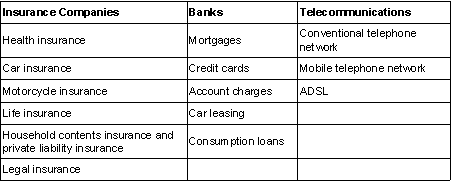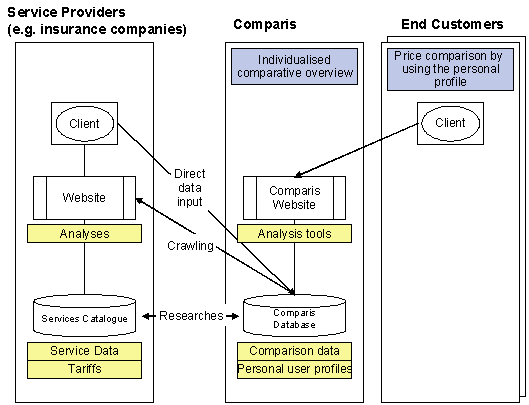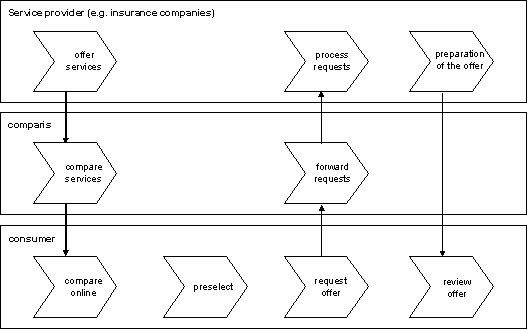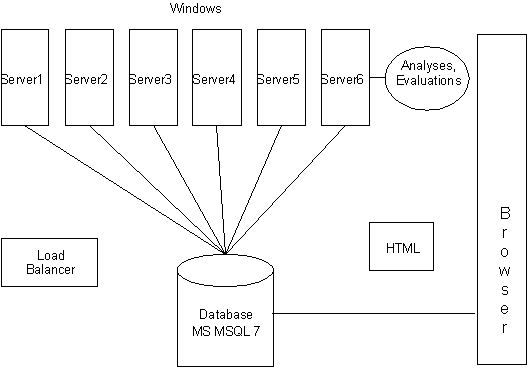Interactive online comparisons from the finance; insurance; and telecommunications sectors at comparis.ch
comparis.ch AG is an E-Business company that offers interactive online comparisons from the finance, insurance, and telecommunications sectors for consumers in the internet. The company operates as an intermediary between suppliers and consumers. The analysis tool is based on a database that contains providers’ information on current tariffs, premiums, and services. This database is populated with data either in cooperation with the suppliers using specific exchange interfaces or by means of crawling websites or by research and manual input. The overviews are used by consumers as an important basis for selecting a suitable provider. A large percentage of the offers obtained through the website lead to subsequent contracts.
Inhaltsverzeichnis
1. The Company2. E-Business Strategy
Website
3. Integration Solution
Business Perspective, Cooperative Model, Passive Model, General Principles, Process View, Application View, XML Interface, Web Crawling, Technical View
4. Implementation
Project management and redesign of the processes, Software solution/Programming
5. Operation
Maintenance, Costs and Benefits, Benefits, Profitability
6. Success Factors
1. The Company
In May 1996, Richard Eisler, an economist, founded Comparis GmbH in Ettlingen/BL. The object of the company is to provide consumers with a transparent cost comparison for various service products. comparis.ch has been listed since June 2000 with its head offices in Zürich. Majority ownership is held by the employees. At the moment, Comparis has approximately 30 employees.
Background:
At the time the company was founded, the internet was about to become an accepted business medium, for private customers, too. The founders saw an opportunity in this development to use web applications to improve the transparency of tariffs and services in the services sector and so provide an added value service to end consumers. One of their first projects was a comparison of health insurance tariffs. Since the company’s inception, there has been increasing interest among internet users. 1997 marked the 100,000th visitor. By 2000, this figure had increased to over 3.6 million. The E-Business application presented in this case study was put into operation in August 2001.
Industry sector, products, and target group:
Comparis is an intermediary between service providers (health insurance companies, insurance companies, banks, and telecommunications companies) and consumers and consequently, it operates in different industry sectors. Its customers come from both the B2B sector (service providers) and also from the B2C sector (end customers). The actual product, i.e. the “Comparis Idea”, is an independent and neutral provider of tariff comparisons with the objective of creating greater market transparency for end customers. The tariff comparisons can be generated by the consumers themselves with the help of various E-Services on the Comparis website.
In August 1996, the first comparison of Swiss health insurance premiums was published on the website (www.krankenkassen.ch). Since then, Comparis has continually expanded the available products. In 1998, a comparison of telephone and bank fees was added. In 1999 and 2000, Comparis further expanded the health insurance comparison and its product range to include comparisons of car and life insurance, mortgages and online brokers.
The following service comparisons are now offered on the website:

There is no direct competition. Comparis is characterised by a wide selection of information as well as by country-specific know-how, which gives it a home field advantage even against larger international providers like finanzscout, for example..
Corporate Vision:
Comparis supports consumers in selecting services and regards itself as a decision preparer that creates transparency in the tariff jungle. The word decision generally means the choice of an alternative course of action that has proven to be the best alternative in view of the objective. Classifying decisions according to the actual structure of the decision task at hand enables structured, semi-structured, and unstructured decisions to be differentiated. If this is a structured decision, the decision situation is known along with possible actions and consequences as well as the goals. In this connection, Comparis takes over the task of structuring decision processes. If the decision task is structured, it is much easier for the consumer to make a decision.
Therefore, Comparis’ goal can be described as follows:
2. E-Business Strategy
Value of E-Business in the corporate strategy:
Comparis is a new economy company that has orientated its entire business operations around E-Business. Its services are provided exclusively through various, specialised E-Services on its website. The value of its E-Business applications for its corporate operations is consequently high.
In the industry sectors where Comparis offers service comparisons, the use of information technology does not necessarily rate very highly. Here, information technology provides efficient support to processes, and in the case of insurance companies, it helps to calculate insurance amounts or to issue policies.
Partners:
Creating the website
The internet solution was developed internally by one of the co-founders. For selected work, external IT partners were involved for contract programming. The only external IT service that was used was server support by an external company. This makes administration easier and makes it possible to concentrate on core competencies. External consultants were called in selectively to complement technical competence.
Business partners
Comparis’ business partners are individual providers of the services being compared. The company strives to provide comprehensive tariff and services comparisons in all areas that are offered. Here, it is not important whether a company cooperates with Comparis or not. However, Comparis is often dependent on providers supplying the appropriate data. There are "cooperative providers“ actively involved in Comparis' service and who enter their data themselves or make it possible to access the data through an electronic interface. On the other hand, there are also providers that shy away from comparisons and do not provide any data. In such cases, Comparis must make the effort to gather their service data another way. It is Comparis’ objective to cover at least 80 per cent of each specific market.
3. Integration Solution
Comparis’ product selection is based on compiling data from various sources. There are two different directions of data transfer:
- Entering service data from providers (data integration), and
- Forwarding requests for proposals to the providers (via e-mail or via electronic interfaces to their proposal systems).
Figure 3.1 shows two different ways of integrating service data into the Comparis website. For providers that do not actively supply data to Comparis, the data is either collected by Comparis employees and entered into the respective databases or is individually compiled for the consumers by means of web crawling. Consumers use a standard web browser to access the desired E-Service. When the comparison is complete, the consumer may initiate an online request for proposal using the Comparis website.

Figure 3.1: Various types of data integration
Business Perspective:
Depending on how cooperative the providers are, Comparis enters into either a cooperative relationship or a more passive relationship with its business partners. Potential service providers are actively approached by Comparis and the company tries to convince them of the benefits that will result from active participation.
Cooperative model: Provider supplies the data
For some comparisons, it is possible to enter service data directly into the Comparis database using web forms. In addition, there is an XML interface for entering data into Comparis comparisons electronically.
Passive model: Comparis obtains the data itself
A second possibility is that Comparis does its research by means of crawling and collects data for manual entry, which it then makes available to consumers.
Forwarding requests for proposal
For cooperative partners, the consumer has the possibility of generating a request for proposal on the website. The RFPs are entered in the Comparis website and then forwarded to the respective companies by e-mail or via an electronic interface.
Comparis follows the following general principles when compiling tariff and service comparisons:
- Comparis is orientated to the interests of the consumers and therefore strives to include those providers of products or services in the comparison that as a whole cover at least 80% of the total market.
- To be included in a Comparis comparison, the prices and services of a provider must be structured in such a way that they are comparable to other offers.
- In terms of market transparency, Comparis includes providers in the comparisons regardless of the existence of any possible business relationships.
- An existing business relationship between Comparis and a provider has no influence on the ranking of the provider in comparisons.
- Comparis compiles the tariff and service comparison ranking lists only according to objective, measurable criteria on the basis of the data provided by the providers.
Process view:
On the website, persons looking for information can conduct personal comparisons of financial and insurance services as well as telecommunications tariffs based on their requests, or alternatively their personal profiles. This brings Comparis, providers and consumers closer together. The consumer creates a comparison based on his/her requirements, finds out which product matches these requirements the best, and informs the preferred provider directly online. Comparis’ E-Services are permanently available online. They are also actively used and tested by the providers being compared. The providers continually check the correctness of the results (competitive analysis). They inform Comparis if there is an incorrect result. Consequently, consumers have a unique guarantee of the independence, correctness, and neutrality of the Comparis products.

Figure 3.2: Process overview
The typical course of the process is shown in Fig. 3.2. The web application receives data from the insurance companies, banks, and telecommunications companies. This data is collected and made available for comparative analyses.
The following is an example of a typical order of events for choosing a health insurance company: The customer enters his/her profile, i.e. post code, age, requested coverage, etc. Based on this information, the Comparis comparison tool calculates the tariffs of the individual providers and creates a tabular overview. The customer makes a pre-selection and chooses those providers from whom he/she would like an offer. The requests for proposal are forwarded by Comparis to the respective providers. Subsequently, the providers contact the potential customer directly.
In addition, Comparis contacts the customer again to ask about the further course of the process. Comparis finds out whether the customer received an offer and when it was received, whether the offer met his/her expectations, and whether he/she will accept the provider’s offer. Comparis receives feedback from the customer for a third of such inquiries. Above and beyond this, further information can be used for push services. For example, customers are informed by e-mail when there is a new comparison or if there have been any fundamental changes to tariff structures.
Application view:
The core of the application architecture is the analysis tool with the underlying comparison database. With its web application, Comparis is capable of responding to very heterogeneous requests and adapts to the existing system landscape on the provider side. Here, the breadth of the integration spectrum is very effective.
On the one hand, the providers are offered an XML interface for importing data. On the other, data is extracted from providers' systems by means of web crawling. Web crawlers are programmes that search the World Wide Web for the stipulated content through successive sequences of hyperlinks. It is possible to recognise the content through methods of machine learning.
The requests for proposal are forwarded to the respective providers in a variety of ways. This includes, for example, regular mail, SMTP mail interfaces, or the use of SOAP services. With SOAP it is possible to call up objects on other computers. SOAP is platform- and language-independent.
Technical view:
The E-Services offered by Comparis are based on applications that it developed itself. The basic system runs on a Microsoft IIS Server and an MS SQL database. SMTP and http are used for integration.

Figure 3.3: IT infrastructure
The architecture is based on standard components. Windows basic technology is used primarily. There are no particular requirements on the part of providers and end customers. Internet access is sufficient for both entering data and using the analysis tools.
4. Implementation
Since the inception of the company, there has been continuous work on improving and enhancing the solution. The implementation is an ongoing process.
Project management and redesign of the processes:
Generally speaking, care was taken in the overall process to make sure that the long-term strategy would be achieved by means of detailed operative goals. This was mainly necessary to reduce complexity and was identified by the founders as an important success factor. Incremental growth of the system guarantees clarity at all times.
Regarding IT project management, iterative prototyping was used. The system was continually expanded with partial solutions so that there was always a stable product selection.
Software Solution/Programming:
The server application was created with Visual Basic scripts. The main reason for this decision was the desire for a manageable and incrementally expandable technology solution (investment protection) that was widespread in the market.
Perfect control over the existing platform was a higher priority that trying to have "the" perfect platform.
5. Operation
Maintenance:
The entire software platform was developed and is maintained by Comparis itself. No external partners were used for programming. Maintenance and ongoing improvements are also done internally. The servers are hosted externally. The technical project manager is responsible for implementing the ideas and technology.
Costs and benefits:
Comparis quantifies its costs as “cost per contact”. The company has fixed costs for the company premises, maintenance of the infrastructure, as well as cost of wages and licences.
The benefits must be looked at individually for all participants.
- For consumers, the benefits are very high since they incur no costs. The use of Comparis products on their part can result in cost savings by using a cheaper provider. They have the benefit of a transparent display of the services from many potential providers.
- The benefits for the providers must be viewed differentially. On the one hand, cheap providers profit from the market transparency and the new customer contacts. On the other, new competitive situations could arise that are not desirable in all cases. By getting into online sales, providers are mainly trying to lower acquisition costs. In this case, contact mediation by Comparis can be rated as very beneficial since experience has shown that up to 50% of all forwarded requests for proposal have led to a signed contract – depending on the sector and provider. It is worth mentioning that there is only an average of 1.5 requests for proposal per customer, which means that the decision for a product is made to a great extent on the basis of the comparison.
- For Comparis, the added value is found in mediating between consumers and providers. The cooperating service providers pay a flat rate as compensation for each contact made (RFP).
Profitability:
Comparis keeps implementation and overhead costs low and operates profitably.
6. Success Factors
Comparis is a successful player in the new economy. Its essential success factors are:
- the combination of heterogeneous services
- the efficient use of existing resources
- the flexibility and reaction speed with regard to market demands
- the existence of country-specific know-how and a brand name in Switzerland
In the foreground of the technical solution is the fact that the company concentrated on the essentials of the technology. Always pursuing the latest trends in information technology can distract from the actual processes and make the cost of integration, maintenance, support, modifications, and installations incalculable. The openness of the technical solution makes it possible to integrate almost any service provider. This is the most important condition in guaranteeing the objective of at least 80 per cent market coverage.
The existing partnerships are proving to be long-term and the acquisition of new customers for the partners is successful. As a result, the cooperative model is being regarded as necessary by many providers.
Specialities of the solution:
The special feature of the solution is that new market transparency is created for consumers in very heterogeneous lines of business. On the Comparis website, customers receive information that would be difficult or impossible to get without this support. As a result, they have a better foundation for their decisions.
It is worth noting that even difficult to compare services, such as car insurance for example, which is determined individually by many parameters, can be compared on the Comparis website with regard to premiums and services.
On the providers’ side, the special feature is the market overview, which is sometimes welcome (for cheap providers), but also sometimes undesirable.
Experience:
Difficulties
Keeping the data up-to-date is a major challenge for Comparis. Moreover, the recently acquired transparency for consumers is not welcomed by all service providers. In particular in the start-up phase of business operations, there was major distrust of having too much market transparency.
Benefits
The main advantage for consumers is found in the provision of information that is always up to date. Providers are given inestimable help with customer acquisition, which is particularly costly in the insurance sector.
Lessons learned:
Every resident of Switzerland is confronted by the subject matter of insurance, financial services, and telecommunications at some time in their lives. These three markets provide immense potential. The services that are offered are heterogeneous and in some cases difficult to compare. Usually, customers are only aware of a few of the large selection of providers. The results of a survey conducted on behalf of Comparis in September 2002 showed that most insured persons often are unaware of the names of any health insurance companies other than their own. Here, Comparis creates transparency and consequently fulfils a genuine market need.
It will never be possible for the insurance industry to use the internet for all of its products and for all customer segments. The sales force will retain its importance as a significant customer loyalty instrument and as a sales channel for products requiring explanation. The internet will establish itself as a sales channel for standardised products, primarily for property insurance. In accordance with estimates by Comparis, about one third of all insured persons used the comparis.ch online marketplace to change their insurance companies last year. The platform provides an economical entry into online sales for many providers. For providers with their own internet platforms, it represents the only alternative of even coming close to amortising their investment.



